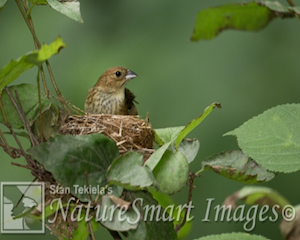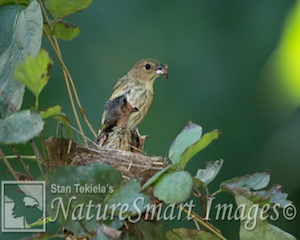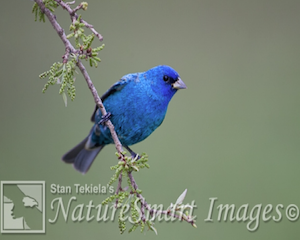
Indigo Bunting—A Familiar Summer Visitor
In this week’s column, Stan Tekiela shares with us the hard work of an Indigo Bunting mother during nesting season.
 Every now and then, I am fortunate enough that people will give me a call to say they found something cool in their yard and wonder if I want to photograph it. Recently, that very thing happened. It started with a text message from a homeowner who came across a nest when he was clearing the edge of his wooded yard. It was a small nest, low to the ground, and he felt bad about inadvertently exposing the nest by clearing the brush. He took a picture and texted it to me, saying he thought it was a hummingbird nest.
Every now and then, I am fortunate enough that people will give me a call to say they found something cool in their yard and wonder if I want to photograph it. Recently, that very thing happened. It started with a text message from a homeowner who came across a nest when he was clearing the edge of his wooded yard. It was a small nest, low to the ground, and he felt bad about inadvertently exposing the nest by clearing the brush. He took a picture and texted it to me, saying he thought it was a hummingbird nest.
When I received the text titled “hummingbird nest“ I got excited, but the moment I looked at the pic I knew immediately it wasn’t a hummer. Four beautiful white eggs were in the nest. Hummingbirds only have two eggs at the max, so it couldn’t be a hummingbird.
The next day, I stopped by and walked across the yard with the homeowner towards the nest. We weren’t 40 feet away when I saw the small nest and a tiny bird that jumped from the nest and dropped right to the ground and disappeared. “Now that is interesting,” I thought to myself. I didn’t get a good enough look to see what it was.
About 10 minutes later, I had my blind set up at a very respectful distance, and I sat and waited for the mystery bird to return. It took only a few minutes before the mother returned, and I could clearly see it was an Indigo Bunting. This would be only the second nest I have ever seen of this species in the 30 years I have been a professional wildlife photographer.
 This was the beginning of an amazing adventure for this Indigo Bunting mother. Over the next two weeks, this mother would face many obstacles while trying to raise a family. I came back many times to capture the amazing saga of this bunting.
This was the beginning of an amazing adventure for this Indigo Bunting mother. Over the next two weeks, this mother would face many obstacles while trying to raise a family. I came back many times to capture the amazing saga of this bunting.
The first of many obstacles the mother faced was living with predators. The first morning I was there, a pair of Cooper’s Hawks were visiting the feeding station just 50 feet behind me. These woodland hawks make a living by eating other small birds. I would watch as the mother Indigo would slip out of the nest to take a break and stealthfully move about the forest floor, gathering something to eat for herself before slipping into the nest to incubate. The ever-present danger was just yards away.
A couple days later, the homeowner contacted me again to say that something had happened and he wanted me to stop by and take a look. Two of the Indigo Bunting eggs were missing, and a new, larger, spotted egg was in their place. Yes, a Brown-headed Cowbird found the newly exposed nest and took out 2 eggs and replaced it with one of her own. Cowbirds are nest parasitic birds that lay their eggs in other birds’ nests. Knowing that the Indigo Bunting had already been incubating for nearly 10 days, I felt this shouldn’t be too much of a threat.
The very next day, the two Indigo Bunting babies hatched, which spelled doom for the cowbird egg because the mother wouldn’t be incubating while feeding her newly hatched babies. She had dodged another bullet because the cowbird baby most likely would have pushed out the Indigo Bunting babies.
The next time I was there photographing, an entire family of Broad-winged Hawks were flying around the yard. Freshly out of the nest, the young hawks were all over the yard, begging for food from their parents. This was another predator challenge for the Indigo mother.
 The babies grew quickly, with mom feeding them juicy caterpillars and a wide variety of other insects. I could hear the male Indigo Bunting singing from the treetops nearby, but he never came in to help the mother feed the young. She was doing this all on her own.
The babies grew quickly, with mom feeding them juicy caterpillars and a wide variety of other insects. I could hear the male Indigo Bunting singing from the treetops nearby, but he never came in to help the mother feed the young. She was doing this all on her own.
On my last visit, I set up my blind and settled in to wait. The mother Indigo came in to feed the babies a couple large caterpillars. The babies were so big they nearly jumped right out of the nest to grab their meal. Then, just like magic, one of the babies got on the rim of the nest and fluttered its wings. While the second baby watched, the first one climbed up the short sticks holding the nest, flapped its wings, and flew off into the forest. Inspired by its sibling, the second baby did the same thing; off they both went into the world, healthy and with an amazing mother to look over them.
It is such a privilege to witness the dramas—and especially the successes—of the natural world.
If you enjoyed Stan’s post, you may consider one of his amazing nature books: Majestic Eagles; The Lives of Wolves, Coyotes, and Foxes; or Backyard Birds: Welcomed Guests at our Gardens and Feeders. Young readers will delight in his award-winning children’s books, such as Whose Butt?, Critter Litter, and his latest, Jump, Little Wood Ducks.
You can follow Stan on Facebook and Twitter, or contact him via his web page. Stan’s nationally syndicated NatureSmart Column appears in more than 25 cities spanning 5 states (Minnesota, Wisconsin, Michigan, Illinois, and Pennsylvania) and is circulated to more than 750,000 readers. Stan’s author page on Amazon features some amazing videos! Check them out, and follow him for updates.
For more stories about wildlife and nature, sign up for our newsletter now!
More posts from Stan:
Indigo Bunting—A Familiar Summer Visitor
The Nesting Behaviors of Sandhill Cranes
Big Birds, Baby Birds, Birds Everywhere
Stan Tekiela observes Marsh Wrens
The Magical, Mystical World of Sandhill Cranes



Pingback: Magical, Mystical Sandhill Cranes - Adventure Publications
Pingback: The Short-tailed Weasel: A Tiny Bundle of Energy - Adventure Publications
Pingback: Stan Tekiela Photographs a Star-nosed Mole - Adventure Publications
Pingback: Marsh Wrens Are Busy Nest Builders - Adventure Publications
Pingback: Fall is Mushroom Season - Adventure Publications
Pingback: Picking a Favorite Bird is Hard to Do - adventurepublications.net
Pingback: Trumpeter Swans Are Back in the Wild - Adventure Publications
Pingback: Trumpeter Swans Are Back in the Wild - adventurepublications.net
Pingback: Picking a Favorite Bird is Hard to Do - Adventure Publications
Pingback: Stan Tekiela Studies Red-headed Woodpeckers - Adventure Publications
Pingback: The Argiope Spider, the Predator of the Prairie - Adventure Publications
Pingback: Pumpkins, an Incredible Edible - Adventure Publications
Pingback: About Blue Jays, Flying Squirrels, and Chipmunks - Adventure Publications
Pingback: The Northern Goshawk, a Secretive Bird - Adventure Publications
Pingback: Stan Tekiela Captures Grandeur and Beauty of Bighorn Sheep - Adventure Publications
Pingback: The Amazing World of the Snail Kite - Adventure Publications
Pingback: The Amazing Skills of Flying Squirrels - Adventure Publications
Pingback: About the Hibernation of Bears and other Mammals - Adventure Publications
Pingback: Stan Tekiela Captures Grandeur and Beauty of Bighorn Sheep - adventurepublications.net
Pingback: About Deer, Wildlife, and Piebaldism - Adventure Publications
Pingback: New - adventurepublications.net
Pingback: Stan Tekiela Photographs Bighorns in Wyoming - Adventure Publications
Pingback: The Virginia Opossum—One of the Coolest Critters - Adventure Publications
Pingback: The Oystercatcher Sleeps with One Eye Open - Adventure Publications
Pingback: Stan Tekiela Shares His Love for Moose - Adventure Publications
Pingback: The Indian Pipe, One of Nature’s Many Wonders - Adventure Publications
Pingback: Big Birds, Baby Birds, Birds Everywhere - Adventure Publications
Pingback: Great Blue Heron Nesting - Adventure Publications
Pingback: March Chores and Maple Syrup - Adventure Publications
Pingback: Horned Lark—A One-of-a-Kind Bird - Adventure Publications
Pingback: The Spruce Grouse—A Most Elusive Bird - Adventure Publications
Pingback: Searching for the Elusive Bobcat - Adventure Publications
Pingback: Winter—A Challenge for Our Resident Birds - Adventure Publications
Pingback: The Christmas Tree Conundrum - Adventure Publications
Pingback: The Skunk — A Remarkable Critter - Adventure Publications
Pingback: Dark Meat or Light Meat - Adventure Publications
Pingback: The Start of the Elk Rut - Adventure Publications
Pingback: Manatees, Florida’s Gentle Giants - Adventure Publications
Pingback: Millions of Birds Gather in South Central Nebraska - Adventure Publications
Pingback: The Wood Stork: A Most Amazing Bird - Adventure Publications
Pingback: Birds like the Chickadee Sing in Spring and Summer - Adventure Publications
Pingback: Wildflowers Carpet the Great Smoky Mountains National Park - Adventure Publications
Pingback: Naturalist Stan Tekiela Describes His Profession - Adventure Publications
Pingback: Wild Turkeys No Threat to Pheasant Population - Adventure Publications
Pingback: The Eastern Spotted Skunk, an Unassuming Critter - Adventure Publications
Pingback: The Amazing Skills of Owls - Adventure Publications
Pingback: The Life Cycle and Behaviors of the Common Loon - Adventure Publications
Pingback: Bird Trivia: Amazing Facts to Wow Any Bird Lover - Adventure Publications
Pingback: The Mystery of Bird Migration - Adventure Publications
Pingback: Amazing Bird Trivia for Bird Lovers - Adventure Publications
Pingback: About Birdsongs, Calls, and More - Adventure Publications
Pingback: Black Bears Are Exciting Creatures to Photograph - Adventure Publications
Pingback: Everything Needs to Eat, Including the Mink - Adventure Publications
Pingback: Red Fox Sighting in Yellowstone National Park - Adventure Publications
Pingback: A Healthy Osprey Population is Thriving in the Nation - Adventure Publications
Pingback: Stan Tekiela Reports from Alaska - Adventure Publications
Pingback: It’s a bird, it’s a plane—no, it’s a super moth! - Adventure Publications
Pingback: Grizzly Bears, Fearsome and Amazing - Adventure Publications
Pingback: Grebes are Rushing and Dancing on the Water - Adventure Publications
Pingback: Stan Tekiela Observes the North American Beaver - Adventure Publications
Pingback: A Blue Jay Picture Worth Waiting For - Adventure Publications
Pingback: Raccoons Explore their New Home after Release into the Wild - Adventure Publications
Pingback: The Meadow Vole, a Stout Little Critter - Adventure Publications
Pingback: Tundra Swans Migrate in Flocks of Hundreds - Adventure Publications
Pingback: Burrowing Owls - Adventure Publications
Pingback: Woodschucks: The True Champion of Hibernation - Adventure Publications
Pingback: Owls Are Amazing—Stan Tekiela Tells us Why - Adventure Publications
Pingback: Capturing the Ultrasonic Sounds of the Flying Bat - Adventure Publications
Pingback: Searching for the Elusive Western Screech-owl - Adventure Publications
Pingback: Flying Squirrels Shine Pink - Adventure Publications
Pingback: Nesting in the Dog Days of Summer - Adventure Publications
Pingback: Stan Tekiela Presents: The Pileated Woodpecker - Adventure Publications
Pingback: Sharp-tailed Grouse Fascinates with Mating Behavior - Adventure Publications
Pingback: Stan Tekiela Takes a Look at the American Crow - Adventure Publications
Pingback: Fun Facts About North American Birds - Adventure Publications
Pingback: Grey Wolves in Yellowstone National Park: The Ultimate Wildlife Encounter - Adventure Publications
Pingback: Good to Know: The American Bison Is Not a Buffalo - Adventure Publications